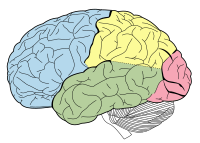
Photo from wikipedia
Over the past few years, it has become standard to describe brain anatomical and functional organisation in terms of complex networks, wherein single brain regions or modules and their connections… Click to show full abstract
Over the past few years, it has become standard to describe brain anatomical and functional organisation in terms of complex networks, wherein single brain regions or modules and their connections are respectively identified with network nodes and the links connecting them. Often, the goal of a given study is not that of modelling brain activity but, more basically, to discriminate between experimental conditions or populations, thus to find a way to compute differences between them. This in turn involves two important aspects: defining discriminative features and quantifying differences between them. Here we show that the ranked dynamical stability of network features, from links or nodes to higher-level network properties, discriminates well between healthy brain activity and various pathological conditions. These easily computable properties, which constitute local but topographically aspecific aspects of brain activity, greatly simplify inter-network comparisons and spare the need for network pruning. Our results are discussed in terms of microstate stability. Some implications for functional brain activity are discussed.
Journal Title: Scientific Reports
Year Published: 2022
Link to full text (if available)
Share on Social Media: Sign Up to like & get
recommendations!